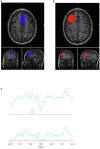Imaging oxidative stress in brains of chronic methamphetamine users: A combined 1H-magnetic resonance spectroscopy and peripheral blood biomarker study
- PMID: 36704729
- PMCID: PMC9871559
- DOI: 10.3389/fpsyt.2022.1070456
Imaging oxidative stress in brains of chronic methamphetamine users: A combined 1H-magnetic resonance spectroscopy and peripheral blood biomarker study
Abstract
Introduction: Preclinical data suggest methamphetamine (MA), a widely used stimulant drug, can harm the brain by causing oxidative stress and inflammation, but only limited information is available in humans. We tested the hypothesis that levels of glutathione (GSH), a major antioxidant, would be lower in the brains of chronic human MA preferring polysubstance users. We also explored if concentrations of peripheral immunoinflammatory blood biomarkers were related with brain GSH concentrations.
Methods: 20 healthy controls (HC) (33 years; 11 M) and 14 MA users (40 years; 9 M) completed a magnetic resonance spectroscopy (MRS) scan, with GSH spectra obtained by the interleaved J-difference editing MEGA-PRESS method in anterior cingulate cortex (ACC) and left dorsolateral prefrontal cortex (DLPFC). Peripheral blood samples were drawn for measurements of immunoinflammatory biomarkers. Independent samples t-tests evaluated MA vs. HC differences in GSH.
Results: GSH levels did not differ between HC and MA users (ACC p = 0.30; DLPFC p = 0.85). A total of 17 of 25 immunoinflammatory biomarkers were significantly elevated in MA users and matrix metalloproteinase (MMP)-2 (r = 0.577, p = 0.039), myeloperoxidase (MPO) (r = -0.556, p = 0.049), and MMP-9 (r = 0.660, p = 0.038) were correlated with brain levels of GSH.
Conclusion: Normal brain GSH in living brain of chronic MA users is consistent with our previous postmortem brain finding and suggests that any oxidative stress caused by MA, at the doses used by our participants, might not be sufficient to cause either a compensatory increase in, or substantial overutilization of, this antioxidant. Additionally, more research is required to understand how oxidative stress and inflammatory processes are related and potentially dysregulated in MA use.
Keywords: glutathione; inflammation; magnetic resonance spectroscopy; methamphetamine; oxidative stress; substance use disorder.
Copyright © 2023 Watling, Jagasar, McCluskey, Warsh, Rhind, Truong, Chavez, Houle, Tong, Kish and Boileau.
Conflict of interest statement
The authors declare that the research was conducted in the absence of any commercial or financial relationships that could be construed as a potential conflict of interest.
Figures



Similar articles
-
Exploring brain glutathione and peripheral blood markers in posttraumatic stress disorder: a combined [1H]MRS and peripheral blood study.Front Psychiatry. 2023 Jun 2;14:1195012. doi: 10.3389/fpsyt.2023.1195012. eCollection 2023. Front Psychiatry. 2023. PMID: 37333909 Free PMC article.
-
(1)H-magnetic resonance spectroscopy ((1)H-MRS) in methamphetamine dependence and methamphetamine induced psychosis.Schizophr Res. 2014 Mar;153(1-3):122-8. doi: 10.1016/j.schres.2014.01.029. Epub 2014 Feb 12. Schizophr Res. 2014. PMID: 24529366
-
Methamphetamine-Triggered Neurotoxicity in Human Dorsolateral Prefrontal Cortex.Galen Med J. 2021 Feb 2;10:e2016. doi: 10.31661/gmj.v10i0.2016. eCollection 2021. Galen Med J. 2021. PMID: 35496352 Free PMC article.
-
Antioxidant defense in schizophrenia and bipolar disorder: A meta-analysis of MRS studies of anterior cingulate glutathione.Prog Neuropsychopharmacol Biol Psychiatry. 2019 Apr 20;91:94-102. doi: 10.1016/j.pnpbp.2018.08.006. Epub 2018 Aug 17. Prog Neuropsychopharmacol Biol Psychiatry. 2019. PMID: 30125624 Review.
-
Methamphetamine use and cognitive function: A systematic review of neuroimaging research.Drug Alcohol Depend. 2019 Jan 1;194:75-87. doi: 10.1016/j.drugalcdep.2018.08.041. Epub 2018 Oct 24. Drug Alcohol Depend. 2019. PMID: 30414539
Cited by
-
Exploring brain glutathione and peripheral blood markers in posttraumatic stress disorder: a combined [1H]MRS and peripheral blood study.Front Psychiatry. 2023 Jun 2;14:1195012. doi: 10.3389/fpsyt.2023.1195012. eCollection 2023. Front Psychiatry. 2023. PMID: 37333909 Free PMC article.
-
A Mechanistic Review on Toxicity Effects of Methamphetamine.Int J Med Sci. 2025 Jan 1;22(3):482-507. doi: 10.7150/ijms.99159. eCollection 2025. Int J Med Sci. 2025. PMID: 39898237 Free PMC article. Review.
References
-
- United Nations. World drug report 2019 united nations publication 2019. New York, NY: United Nations; (2019).
Grants and funding
LinkOut - more resources
Full Text Sources
Research Materials
Miscellaneous

